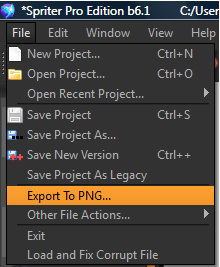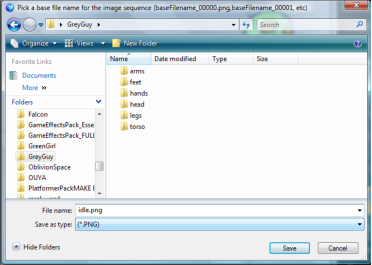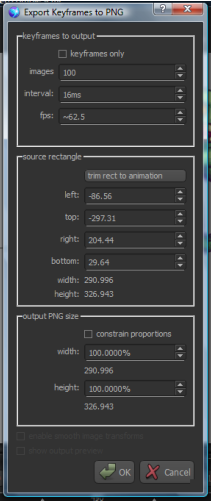
Ideally you’ll be able to use your tweened and optimized Spriter animations directly in the game authoring
system of your choice, but obviously this can’t always be the case. Sometimes you’ll need to create
animations for a game engine that can’t support Spriter files directly.
Similarly, sometimes you might create an animation for things like explosions which end up using dozens
of tweened, rotating and scaling images at once, but plastering your game-screen with lots of these
explosions might adversly effect your frame-rate. Therefore it would be better for your game if the
explosion could be converted to just a sequence of full frame images (to reduce the need for all the
seperate draws and tweening calculations).
For these types of circumstances, Spriter lets you export finished animations as sequential images at any
frame rate (number of frame images per second) you’d like.
Here’s how:
1) Once your animation is finished, make sure that animation is
selected in the Animations Palette and then from Spriter’s menu choose
File/Export To PNG.
Exporting Animations as Sequential Images






2) A file selector will appear, allowing you to designate the location
and name for the images to be saved. Navigate to or create the folder
you’d like the images to be saved in and then type the name for the
images and press enter or click on the save button.
3) The Export Keyframes To PNG Dialogue box will appear, giving you a
plethora of options to choose from while exporting your animation as
sequential images. First, Decide if you want to only export the keyframes
themselves, if you’d like to export frames based on a specific number of
frames per second, or if you’d lust like to tell Spriter how many frames
total the export should create for the entire animation. You can also just
tell Spriter to export an image per however many miliseconds you’d like.
These are the first 3 options in the palette.


4) Using the second part of the export dialogue you can decide how
your animation will be trimmed. Most of the time, You’ll want to leave
it at the default settings, as its sure to not accidentall clip (remove) parts
of any of the frame. But, if you want more specific controll, or
specifically want to crop the animation, then you can use the settings in
this part of the palette to specify exact cropping coordinates.
5) Finally, you can use the bottom section of the palette to decide at
what scale you’d like to export your animation. By default it will be set
to 100 percent. (actual size). Just use these settigns to determind what
size you’d like the animation exported to. Once you’ve decide and
you’ve made sure all the settings from the previous steps are correct,
just click OK and the exporting will commence into the folder you had
selected.

